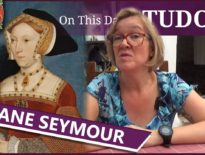On this day in Tudor history, 3rd June 1535, Thomas Cromwell, King Henry VIII's vicar-general, issued orders regarding the royal supremacy to the bishops of the kingdom.
But what was the royal supremacy and what were the clergy expected to do?
Find out all about the royal supremacy, the orders sent and how bishops reacted, in today's talk.
Also on this very same day in history, 3rd June 1535, Sir Thomas More was interrogated in the Tower. You can find out more about what happened in last year’s “on this day” video:
Also on this day in history:
- 1536 – Richard Sampson was nominated as Bishop of Chichester by Henry VIII. Sampson had acted as the King’s proctor in the annulment proceedings of Henry VIII’s marriage to Anne Boleyn in May 1536.
- 1594 – Death of John Aylmer, Bishop of London, at Fulham Palace. He was buried at St Paul's Cathedral.
Transcript:
On this day in Tudor history, 3rd June 1535, on the same day that he had interrogated Henry VIII’s former Lord Chancellor Sir Thomas More in the Tower of London regarding the king’s supremacy and whether he thought it was lawful, Thomas Cromwell, Vicar-General, issued orders regarding the royal supremacy.
But what was the royal supremacy?
Well, during the Great Matter, Henry VIII’s quest for an annulment of his marriage to Catherine of Aragon, a copy of William Tyndale’s “The Obedience of a Christen Man” found its way into the king’s hands. In this book, Tyndale wrote of how rulers were answerable directly to God and not to the pope. After reading this book, Henry VIII declared “This book is for me and all kings to read” and it is his reading of this text that is credited with making the king believe that he could break with Rome and make himself head of the church in England, rather than being answerable to the pope.
The Act of Supremacy was passed in November 1534 and it declared “Albeit the Kynges Majestie justely and rightfully is & oweth to be supreme hede of the Churche of England and so is recognysed by the Clergy of the Realme in their convocacions.” This Act came into force in February 1535. The authority of Rome was abandoned and this was the start of the English Reformation.
On 3rd June 1535 Cromwell sent out royal orders to all bishops in England to preach in support of the royal supremacy and to make sure that their priests also preached every Sunday and feast day renouncing the pope and supporting the royal supremacy. Cromwell’s orders are no longer in existence, but we can tell what was said from the replies he received from bishops. Archbishop Thomas Cranmer replied “concerning the diligent declaration of the King's title and stile of Supreme Head in Earth, immediately under God, of the Church of England. Will satisfy the King's command to the best of my power”, Nicholas Shaxton, Bishop of Salisbury, wrote that he “Rejoices that it has pleased his Highness to write so earnestly to his bishops in this so earnest a cause. Prays Cromwell, whose wisdom, no doubt, stirred him to it, to persevere till the usurped power of that man of Rome be clean abolished”, and The Bishop of Bangor wrote to the king saying that he’d received his letters “concerning the diligent setting forth and sincere preaching within the diocese of Bangor of your most just title of Supreme Head of the Church of England, and the abolition of the usurped power of the bishop of Rome, which I will do or cause to be done with all celerity.” Lots of other bishops replied too, assuring the king and Cromwell that they would obey. Schoolmasters were also to teach their students about the king’s supremacy.
The clergy were also instructed to remove all references to the Pope from mass books and other church books.
Of course, not everybody was on board with these changes, and men like Sir Thomas More, John Fisher, Bishop of Rochester, and the Carthusian monks of London Charterhouse lost their lives as a result of their opposition.
Although, as I said, this break with Rome was the start of the English Reformation, Henry VIII was not changing the faith of England. Henry VIII died a Catholic. He was simply making himself head of the church and denying the authority of the pope. This did allow those of the reformed faith, men like Cranmer and Cromwell, to bring in changes to reform the church, but England didn’t become “Protestant” until Edward VI’s reign and then in Elizabeth I’s reign with her religious settlement.



Leave a Reply